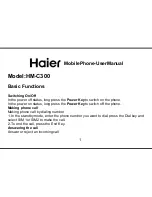
Section 4A: Safety
183
Safety
Turning Off Your Phone Before Flying
Turn off your phone before boarding any aircraft. To prevent possible
interference with aircraft systems, the U.S. Federal Aviation
Administration (FAA) regulations require you to have permission from
a crew member to use your phone while the plane is on the ground.
To prevent any risk of interference, FCC regulations prohibit using
your phone while the plane is in the air.
Turning Off Your Phone in Dangerous Areas
To avoid interfering with blasting operations, turn your phone off
when in a blasting area or in other areas with signs indicating two-way
radios should be turned off. Construction crews often use remote-
control RF devices to set off explosives.
Turn your phone off when you're in any area that has a potentially
explosive atmosphere. Although it's rare, your phone and accessories
could generate sparks. Sparks can cause an explosion or fire, resulting
in bodily injury or even death. These areas are often, but not always,
clearly marked. They include:
䢇
Fueling areas such as gas stations.
䢇
Below deck on boats.
䢇
Fuel or chemical transfer or storage facilities.
䢇
Areas where the air contains chemicals or particles such as grain,
dust, or metal powders.
䢇
Any other area where you would normally be advised to turn off
your vehicle’s engine.
Restricting Children’s Access to Your Phone
Your phone is not a toy. Do not allow children to play with it as they
could hurt themselves and others, damage the phone or make calls
that increase your Sprint PCS Invoice.
Note:
Never transport or store flammable gas, liquid or explosives in the
compartment of your vehicle that contains your phone or
accessories.
Summary of Contents for PCS VI-3155I
Page 2: ......
Page 13: ...Section 1 Getting Started ...
Page 14: ...2 ...
Page 22: ...10 ...
Page 23: ...Section 2 Your Sprint PCS Phone ...
Page 24: ...12 ...
Page 70: ...58 ...
Page 78: ...66 ...
Page 122: ...110 ...
Page 130: ...118 ...
Page 131: ...Section 3 Sprint PCS Service Features ...
Page 132: ...120 ...
Page 156: ...144 ...
Page 182: ...170 ...
Page 188: ...176 ...
Page 189: ...Section 4 Safety Guidelines and Warranty Information ...
Page 190: ...178 ...
Page 200: ...188 ...















































